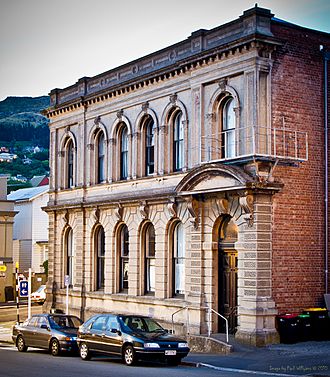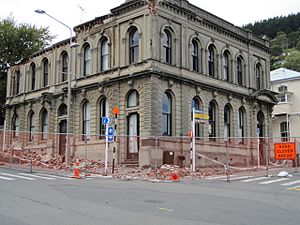Lyttelton Borough Council Chambers facts for kids
Quick facts for kids Lyttelton Borough Council Chambers |
|
|---|---|

Lyttelton Borough Council Chambers on 23 December 2010
|
|
| Etymology | Lyttelton Borough Council |
| General information | |
| Status | Demolished |
| Type | Civic office |
| Architectural style | Italianate |
| Address | 1 Sumner Road |
| Town or city | Lyttelton |
| Country | New Zealand |
| Demolished | June 2011 |
| Client | Lyttelton Borough Council |
| Design and construction | |
| Architecture firm | Collins and Harman |
| Main contractor | Hollis, Williams, and Green |
| Designated: | 12 September 2003 |
| Reference #: | 7525 |
The Lyttelton Borough Council Chambers was the main office for the Lyttelton Borough Council. This council was like the local government for the town of Lyttelton. The building was used from 1887 until the late 1900s. After that, the council moved to other places.
In 1999, the building was sold. It was then used for businesses on the ground floor and homes upstairs. In 2003, it was officially recognized as a historic building by the New Zealand Historic Places Trust. Sadly, the building was torn down in June 2011. This happened after the big 2011 Christchurch earthquake caused a lot of damage.
Contents
Building History
The Lyttelton Borough Council started in 1868. It took over from an earlier local council that began in 1862. In 1886, the council members decided they needed a special building just for their offices.
Planning the New Building
Councils often need to borrow money for big projects. This is called raising a loan. Back then, the public had to agree to these loans. So, in August 1886, a public meeting was held to talk about borrowing £3,000 for the new building. The mayor at the time, Adam Chalmers, led the meeting. A local politician and council member named Harry Allwright also spoke.
The people of Lyttelton voted on the loan during the council elections on 9 September 1886. Most people supported it, with 442 votes for the loan and only 26 against.
Design and Construction
The building was designed by a company called Collins and Harman. They put out a call for builders to offer their prices (this is called a tender). Ten different companies offered to build it. The lowest price came from local builders Hollis, Williams, and Green, and they got the job.
The building was made of brick and had two floors.
- The ground floor was for a court where a resident magistrate (a type of judge) would hear cases. It also had offices for the court.
- The top floor was for the borough council.
The court room was quite large, about 12 by 7.6 meters (39 by 25 feet). The council meeting room was about 14.25 by 7.77 meters (46 feet 9 inches by 25 feet 6 inches). The ceilings were very high, about 4.5 meters (15 feet).
The building faced two streets: Sumner Road (which was called London Street back then) and Oxford Street. It was about 15 meters (49 feet 6 inches) wide on Sumner Road and 18.4 meters (60 feet 6 inches) long on Oxford Street. The building stood about 11 meters (36 feet) tall from the ground to the top edge.
You could enter the court from a door on Oxford Street. The council offices had their own entrance on Sumner Road. The first stone of the building was laid on 29 January 1887. Harry Allwright, who had just become mayor, had his name carved into this stone.
The building didn't have a big opening ceremony. However, the first council meeting was held there on 18 October 1887. The court floor took longer to finish because prisoners helped with the work.
Changes Over Time
Over the years, the court was used less and less. Eventually, the council's meeting room was used for court cases. The council staff then took over the ground floor. As the council grew, they needed more space. In 1978, they bought the Albion Hotel and moved some staff there. Around this time, the Lyttelton Library moved into the old court area of the building.
In 1991, council staff moved again, this time to a building owned by the Lyttelton Port Company. Finally, in 1999, the library moved to its current location. The council then sold the building to private owners. They made sure that the building would be used for businesses downstairs and homes upstairs.

The building was torn down in June 2011 because of damage from the earthquake.
Heritage Status
The Lyttelton Borough Council Chambers was recognized as a Category II heritage building. This means it was considered a place of historical or cultural importance. It received this status from the New Zealand Historic Places Trust on 12 September 2003.

